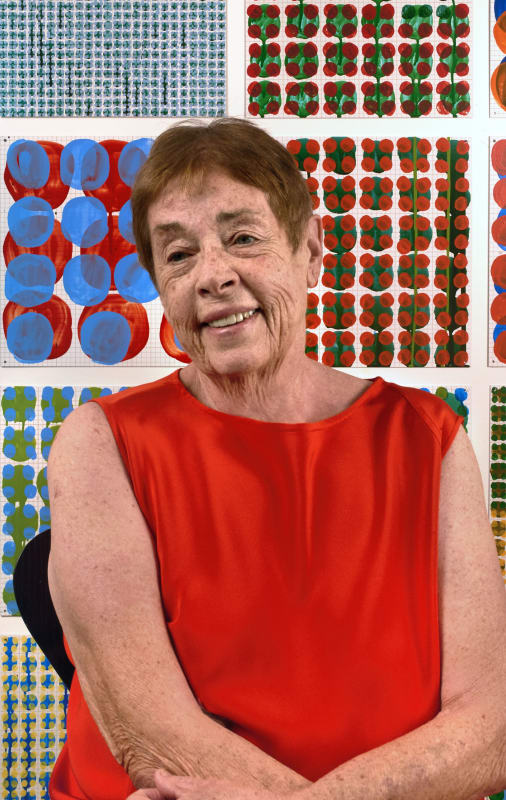BY ARTFORUM
Jennifer Bartlett, who rejected the distinction between figurative and abstract painting in order to create vibrantly energetic works that elude any categorization but their own, died July 25 in Amagansett, New York, at the age of eighty-one. News of her death was confirmed by Paula Cooper Gallery, which represented Bartlett from the earliest stages of her career. One of the very few female artists to gain broad recognition in the 1970s and ’80s, Bartlett elevated the mundane and the modest in paintings that comprised multiple small panels and in installations that paired three-dimensional objects with their painted renderings. Taking the Conceptual grid as a starting point, she expanded it to produce massive works that evoked a starkly contemporary Impressionism. “Close inspection is rewarded,” wrote Jan Avgikos in Artforum last year, “but take a step back and Bartlett’s matter-of-fact technique gives way to an illusionistic space whose linear loops and ghostly outlines suggest fluid motion in the material world—ripples in water, radar echoes, radio frequencies.”
Jennifer Bartlett was born Jennifer Losch on March 14, 1941, in Long Beach, California. Her father owned a construction company and her mother was a former fashion illustrator. After earning her BA from Oakland, California’s Mills College in 1963, she obtained her MFA in 1965 from the Yale School of Art and Architecture. She cited her time at the latter university as having a profound influence on her career. “I’d walked into my life,” she told Elizabeth Murray for a Bomb magazine interview in 2005. In 1964 she married Ed Bartlett (whom she would later divorce) and the couple settled into a large loft in SoHo, with Bartlett traveling between New York, New Haven, and the University of Connecticut, where she was teaching. Inspired by the subway signs she saw on her travels, which she described as looking like “hard paper,” Bartlett came up with one of her signature materials: foot-square steel plates featuring a baked enamel surface atop which was silkscreened a quarter-inch grid.
These plates featured in Bartlett’s earliest widely known work, Rhapsody, 1975–76, a massive reimagining of the mural form incorporating 987 plates and measuring 153 feet wide and seven and a half feet high. The piece was so large that Bartlett has said she saw it in its entirety for the first time when it was installed in the atrium of the Museum of Modern Art, New York. The grid would continue to occupy her for decades, during which she branched out beyond the use of enamel-covered steel to create multipanel works using glass or canvas as a substrate. Though hue and form—especially serial form—were major concerns for Bartlett early on, she increasingly turned her attention to the natural world as the early 1980s dawned. Of particular fascination to her were bodies of water, which for her recalled her childhood growing up by the ocean. These are famously depicted in At Sea Japan, 1980, in which Bartlett deployed the ukiyo-e woodcut method in a six-panel screen print on paper; and in Pacific Ocean, 1984, a thirty-foot-long Photorealistic painting. Her 1980–83 series “In the Garden,” more than two hundred drawings and prints of a garden in Nice, France, presaged future works featuring her own garden in Brooklyn.
Houses were also a favorite subject of Bartlett’s. Her 1988 House with Open Doorcomprises an oil-on-canvas triptych depicting a simple white wooden structure, foregrounded in display by the three-dimensional structure itself. The work echoes her Sea Wall of 1985, in which sculptures of houses and boats sit before a massive painting of their counterparts. Later works by Bartlett take time as their theme, and from about 2004 incorporate fragments of text. Her work remained resonant, dynamic, and unexpected well into 2000s, with works like Leaking Systems, 2001, which radiated vitality through its gridded circles and tilted, shaped canvases; and 2011’s Recitative, which recalled Rhapsodyremade for a digital age.
Bartlett exhibited widely around the world, including at Documenta and the Venice Biennale. The first major survey of her oeuvre was mounted at Minneapolis’s Walker Art Museum in 1985 and traveled to the Brooklyn Museum; retrospectives followed at the Museum of Modern Art, New York, and at Water Mill, New York’s Parrish Art Museum in 2011 and 2014, respectively. Her work is held in the collections of numerous institutions, among them the Honolulu Museum of Art; the Los Angeles County Museum of Art; the San Francisco Museum of Modern Art; the Dallas Museum of Art; the Museum of Fine Arts Houston; the Philadelphia Museum of Art; the Metropolitan Museum of Art, the Museum of Modern Art, the Solomon R. Guggenheim Museum, and the Whitney Museum of American Art, all in New York; and Tate Modern, London.
“My working methods haven’t changed,” she told Artforum’s Julian Elias Bronner in 2013. “Usually I begin a piece by making notes on scraps of paper and using what I have. The notes determine the rules I apply to before beginning a painting. Sometimes the rules change, but I prefer to follow through with them until the end. My work is finished when it’s finished,” she concluded, “when I finish solving the problem.”


